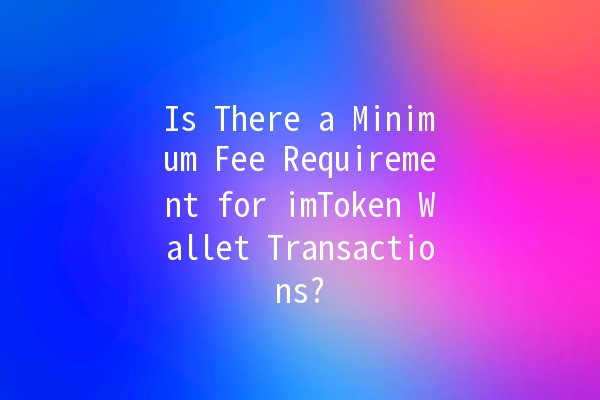In the rapidly evolving world of cryptocurrency, understanding wallet fees is crucial for traders and investors alike. One such wallet that has gained popularity is imToken. Users often find themselves asking: "Is there a minimum fee requirement for transactions made using imToken?" This article seeks to explore this topic in depth, providing valuable insights for both seasoned crypto users and novices.
Transaction fees are charges applied to send or receive cryptocurrency through a blockchain network. They serve multiple purposes: they incentivize miners to process transactions, help prioritize certain transactions over others, and contribute to the overall security and efficiency of the network.
When you initiate a transaction, the fee is typically determined by several factors:

Network Demand: Higher demand can lead to increased fees due to congestion.
Transaction Size: Larger transactions may incur higher fees.
Miner Priority: If you want your transaction to be processed quickly, you might opt to pay a higher fee.
With imToken, users can manage their cryptocurrency assets effectively. The fees associated with imToken transactions vary depending on the network in use. When engaging in transactions, users can choose the fee level based on urgency.
Currently, imToken does not impose a strict minimum fee; however, the fees are determined by the blockchain network itself. Users can set their desired transaction fee, but for optimal transaction speed, it’s advisable to choose a fee that aligns with current network conditions.
Users have the flexibility to set transaction fees within imToken. The wallet’s interface allows users to select a fee level: low, medium, or high. Choosing a higher fee often results in faster transaction processing, especially during periods of high transaction volume on the Ethereum network or other supported networks.
To provide clarity, let's consider the fee structures for major networks like Ethereum and Bitcoin:
Ethereum: Users may typically see fees fluctuating from $0.01 to several dollars, depending on network congestion.
Bitcoin: Similar trends can be observed, where mining fees can vary drastically, often influenced by network traffic and transaction size.
Here are practical tips for managing transaction fees effectively when using imToken:
Regularly check the current conditions of the blockchain network you are transacting on. Various online platforms provide realtime updates on average transaction fees.
If time is of the essence, consider setting a higher fee to expedite processing. For nonurgent transactions, you might opt for a lower fee, saving costs while waiting for confirmation.
Several fee estimator tools can help determine the optimal fee needed for your transaction, allowing for a balance between cost and speed.
If you have multiple transactions to perform, consider batching them together. This can reduce the overall fee per transaction since you may only incur a single fee for multiple transfers.
imToken provides advanced settings that cater to experienced users. Familiarizing yourself with these features allows for improved fee management.
Understanding the implications of transaction fees is essential for the user experience in cryptocurrency wallets like imToken. A favorable fee structure can enhance user satisfaction and loyalty.
If your transaction experiences delays, it may be due to a low fee selection. In some wallets, you can speed up the transaction by increasing the fee, but this depends on the network's current load.
While there is no transaction fee for this action, users should remain aware of the gas fees associated with the underlying blockchain network during the token exchange process.
imToken provides a detailed overview of the transaction fee on the confirmation page before you finalize any transaction. This allows you to make adjustments if necessary.
While tax policies do not directly impact transaction fees, they can influence user's transaction behaviors and fee selections as they seek to minimize costs.
Withdrawing funds typically incurs network fees, but imToken itself does not charge additional withdrawal fees. Always check the network fees for precise amounts.
Many modern wallets offer customization options similar to imToken, allowing users to set their preferred fees based on urgency and transaction complexity.
In summary, imToken does not have a strict minimum fee requirement for transactions. However, users should be vigilant about the current market conditions and network demands when setting their transaction fees. Understanding the nature of blockchain transaction fees can help users optimize their experience when using the imToken wallet. By implementing the tips discussed, users can effectively manage fees and enhance their transaction experiences.
By keeping abreast of fee structures and having an understanding of network demands, cryptocurrency users can make informed decisions that adhere to their financial objectives and bolster security during transactions. As the crypto landscape continues to evolve, adaptability and knowledge will be key to navigating the complexities of digital currencies.